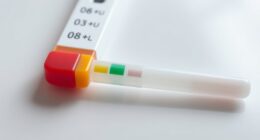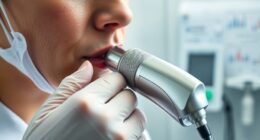Parkinson's disease is often linked to a unique musky or musty smell. Some people compare it to old lockers or damp basements. This scent comes from increased sebum production in the body, which creates a distinct chemical profile. Interestingly, trained dogs can detect this odor with amazing accuracy, helping in early diagnosis. You might not notice these changes yourself, but caregivers and family members often recognize the scent. Discovering this odor can play a crucial role in understanding Parkinson's better. If you're curious about how this scent works and its importance, there's more to explore!
Key Takeaways
- Parkinson's disease is associated with a distinct musky or musty odor due to increased sebum production.
- The unique scent may serve as a potential biomarker for early detection of Parkinson's.
- Individuals with Parkinson's often do not notice the scent changes themselves.
- Trained dogs can detect the Parkinson's scent with over 98% accuracy.
- Recognition of the odor can enhance health measures and promote early diagnosis.
Introduction

Parkinson's disease (PD) isn't just a neurological condition; it can also change how a person smells. You might be surprised to learn that individuals with Parkinson's often emit a unique musky or musty scent. This fascinating discovery was first made by nurse Joy Milne, who noticed the smell on her husband before he was diagnosed.
Research has shown that this distinctive body odor is linked to increased sebum production from sebaceous glands, especially at the back of the neck in people with PD.
Trained dogs have even been able to detect this scent with over 98% accuracy, suggesting it could be a powerful tool for diagnosing the disease early.
The presence of specific chemicals in the sebum of those with Parkinson's may serve as a biomarker, making it easier to spot the disease without invasive tests.
What's even more interesting is that changes in body odor can occur even before a formal diagnosis. By being aware of these scent alterations, you could help in the early detection of Parkinson's, paving the way for quicker intervention and support for those affected.
Description of the Smell

Many people describe the smell associated with Parkinson's disease as a distinct musky or musty odor, which can be quite noticeable. This specific scent is often linked to increased sebum production in the skin, especially from sebaceous glands at the back of the neck. This change in skin odor, sometimes described as oily or greasy, can occur due to altered biochemical processes in individuals with Parkinson’s. Interestingly, researchers have explored using trained “super smellers” or specialized tools to detect this scent as an early diagnostic marker. Unlike the typical **lavender scent description**, which suggests calmness and freshness, the musky or musty odor associated with Parkinson’s tends to be more pungent and persistent.
If you have a heightened sense of smell, you might pick up on these subtle changes even before a formal diagnosis of Parkinson's disease (PD) occurs.
Research shows that the unique chemical profile of sebum in those with PD may serve as a potential biomarker for early diagnosis. Individuals without the disease don't typically have the same sebum composition, which makes the scent even more distinctive.
This difference is so noticeable that trained dogs can detect it, showcasing the power of olfactory sensitivity.
Being aware of this musky odor can be an important step in recognizing early signs of Parkinson's. While the scent changes can be subtle, understanding them can help in better detection efforts.
Source and Composition

Research shows that the chemical profile of sebum in people with Parkinson's differs significantly from that of healthy individuals. This difference may serve as a biomarker, helping to identify the disease even before other symptoms appear.
Specific volatile organic compounds (VOCs) in the sebum of Parkinson's patients are elevated, contributing to this distinctive odor.
Interestingly, individuals with Parkinson's mightn't notice these scent changes themselves, but people with a heightened sense of smell, like Joy Milne, who first identified this odor in her husband, can detect it.
This ability to recognize the unique scent associated with Parkinson's could lead to earlier diagnosis and better understanding of the disease.
Typical Scenarios or Environments

In various settings, you might encounter the distinctive scent linked to Parkinson's disease, particularly in healthcare environments where patients are frequently observed.
When you walk into a clinic or hospital, keep an eye out for people with Parkinson's disease. You may notice a subtle musky odor, which some believe could serve as a potential biomarker for the disease.
This scent arises from changes in the body's chemistry, particularly influenced by the autonomic nervous system. Individuals often don't realize they've this scent, making it harder for them to detect.
However, trained dogs have shown an incredible ability to smell the odor associated with Parkinson's, even achieving over 98% accuracy. This exciting discovery has sparked interest in the scent as a potential diagnostic tool.
In typical scenarios, such as group therapy sessions or check-ups, the scent could become more noticeable to those with heightened senses.
As you learn more about this condition, remember that variations in body odor among those who've developed PD can also occur due to changes in hygiene practices, which might be affected by motor symptoms.
Understanding these environments can help you recognize this unique scent better.
Emotional or Cultural Associations

The distinctive musky odor associated with Parkinson's disease often brings up strong emotional and cultural associations for those who encounter it. For many people, this scent can evoke deep emotional connections, especially for caregivers and family members. They might remember the struggles of loved ones, leading to feelings of nostalgia or sadness.
Cultural perceptions of body odor differ across communities. In some cultures, unique scents are seen as natural, while in others, they may carry stigma or discomfort. This can affect how individuals with Parkinson's are viewed by those around them.
When you recognize this scent, it may inspire a sense of urgency for early diagnosis and treatment. Shared experiences within support groups can help foster empathy and understanding. Hearing personal stories often reinforces the importance of caregivers in noticing subtle changes.
Health or Safety Considerations

How can recognizing the musky odor associated with Parkinson's disease enhance health and safety measures for those affected?
First, understanding that this distinct smell comes from an oily substance produced by sebaceous glands can help. Research suggests that over 98% accuracy in diagnosing PD can be achieved by smelling clothing worn by individuals with the disease. This potential for early detection is vital, as changes in body odor may occur even before formal diagnosis.
If you're a care partner or someone affected by Parkinson's, being aware of these changes can lead to better management of non-motor symptoms.
Individuals often experience a loss of smell, which may prevent them from noticing their own body odor changes. Increased sebum production can also be challenging if motor symptoms hinder personal hygiene practices.
It's essential to seek medical advice if you notice these changes. By recognizing the musky odor, you can take proactive steps to address hygiene and comfort, ensuring a better quality of life for those with Parkinson's.
Final Thoughts

Recognizing the musky odor associated with Parkinson's disease not only aids in early detection but also highlights the importance of ongoing research and awareness surrounding the condition.
This unique odor, first noted by nurse Joy Milne in her husband, can be linked to increased sebum production in the skin. It's fascinating to think that this change in body odor might serve as an early indicator of Parkinson's disease, often occurring before any formal diagnosis.
Research has shown that specially trained dogs can detect this smell with over 98% accuracy, sniffing out clothing worn by individuals with Parkinson's. This remarkable ability opens up exciting possibilities for developing non-invasive diagnostic tools.
Imagine a world where diagnosing Parkinson's disease could be as simple as recognizing a scent!
As we continue to explore this area, awareness and education become crucial. By understanding these signs, you can help others recognize potential symptoms sooner.
Staying informed about the unique odor and its implications can lead to earlier intervention, which is vital in managing Parkinson's disease effectively.
Together, we can support ongoing research and promote awareness to improve lives affected by this condition.
Frequently Asked Questions
Is There a Body Smell With Parkinson's?
Yes, there's often a distinct body odor associated with Parkinson's. You might notice a musky scent, which can be linked to changes in sebum production. This odor can sometimes indicate the disease before other symptoms appear.
What Is the Parkinson's Smell Test?
The Parkinson's smell test identifies a unique scent linked to the disease. You'd notice this musky odor, which trained dogs can detect with high accuracy, potentially aiding in early diagnosis and treatment interventions.
What Disease Has Musky Odor?
You might notice a musky odor associated with Parkinson's disease. This scent, linked to increased sebum production, can often be detected by those close to individuals with the condition even before a formal diagnosis occurs.
Can You Tell if Someone Has Parkinson's?
You can't definitively tell if someone has Parkinson's just by observing them. However, certain signs, like tremors or changes in posture, might suggest a need for further medical evaluation. Always consult a healthcare professional for accurate diagnosis.









